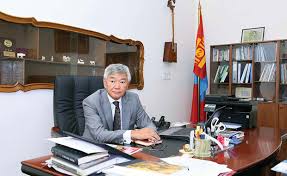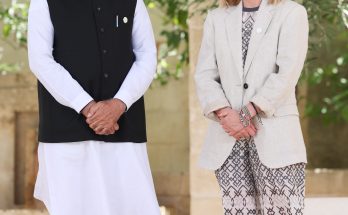
Democracy, development and Buddhism – these are the three pillars of the growing partnership between India and Mongolia. The centuries-old spiritual connections between the two countries have set the stage for a vibrant contemporary relationship. In this wide-ranging conversation with Manish Chand, Editor-in-Chief, India and World and India Writes Network, Mongolia’s Ambassador to India Gonchig Ganbold speaks about Prime Minister Narendra Modi’s transformational visit to Mongolia in May 2015, which set the stage for expanding bilateral economic and development cooperation between the two nations.
A distinguished scholar, the Mongolian ambassador has translated two dozen books, including The Modi Effect by Lance Price, and The President Kh. Battulga, Whom I Know by D.Turmunkh, and previously served in London and Washington D.C. as well as in Ministry of Finance and National Security Council.
The envoy provides an overview of the progress achieved till date in implementing agreements forged during PM Modi’s visit and outlines the potential for enhancing cooperation in areas ranging from Information Technology and agriculture to tourism, culture and films. Blending India’s technology and skills with Mongolia’s raw materials and resources can spur the transformation of Mongolia and India-Mongolia ties, says the envoy.

Q) India-Mongolia relations have acquired an added energy and momentum in the last few years, especially since Prime Minister Narendra Modi’s visit to Mongolia in May 2015. How are the commitments, made during PM Modi’s visit, being implemented? Which areas have seen significant progress?
A) At the outset, I would like to point out that spiritual connections between India and Mongolia transcend centuries. Mongolians consider India with great regard; for them, it’s a sacred land (pavitra bhumi) and the birthplace of Lord Buddha. Buddhism has permeated all aspects of life in Mongolia. It has revived our national identityand is very much interconnected with our way of life and even philosophical and political thinking. So, India, despite the geographical distance, is considered one of the very “close-to-heart” lands by the Mongolians. Based on this cultural and spiritual affinity, the two governments for the first time recognised one another formally and established official diplomatic relations 63 years back.
Soon after the establishment of diplomatic relations, Dr. S. Radhakrishnan visited our country and various leaders, including the Mongolian President, and Prime Minister, have paid visits to India in the past decades. All these visits and cultural encounters have added a new form and content to our bilateral relations. On the whole, we enjoy robust political and diplomatic relations with India.
Prime Minister Narendra Modi’s visit to Mongolia in May 2015 was the first-ever by any Indian prime minister in 60 years. During his visit, the government of India announced
$1 billion Line of Credit to support the expansion of the Mongolian economy and its development. Soon after, India and Mongolia began the process of identification of areas where the Line of Credit could be used effectively. It was after a series of talks and surveys that we reached to the conclusion that the petroleum industry is one of the areas that could be explored as our country exports crude oil and imports lubricated materials and petroleum products. It spends a huge sum of foreign exchange on these items. This refinery can, therefore, help us to not only reduce foreign trade dependency, but also help create new jobs. Besides, it can help us save foreign exchange and result in better allocation of our savings for other essential items.
Further, the oil refinery can be supplemented with other huge projects, like natural gas, railway lines and highways. This will help Mongolia enhance economic regional integration. In that sense, both Mongolian and Indian governments are giving great importance to this project. The pipeline project is being fast-tracked. Expectations are also high that infrastructure construction related to the refinery would be completed by June 2019. If all goes as planned, it can become operational by 2020.
Q) What about cooperation in the Information Technology sector?
A) We have also reached an agreement with the Indian Government in areas of Information Technology (IT). A new IT outsourcing centre is being built in Mongolia based on the Atal Bihari Vajpayee Centre for Excellence in Information & Communication Technology.
As it is known, India’s IT sector is very robust and sophisticated. Mongolia has a vast territory – it’s almost half the size of India and its vastly populated, sandwiched between big markets in the region. It is one of the shortest routes between Europe and Asia. So, IT can not only help Mongolians communicate among themselves, but can also promote banking and IT facilities between nations within that region.
Q) The oil refinery is the showpiece project of India-Mongolia cooperation. Have you been able to identify other projects so that $1 billion LoC can be used efficiently.
A) Mongolia accounts for eight crore livestock and its territorial size is almost half as that of India’s. It is also richly endowed with all kinds of minerals. Eight crore livestock amounts to huge reserves of animal husbandry-based raw materials. India has cost-effective, good quality pharmaceutical products and is an expert in veterinary services. This is yet another area that can be worked upon. This will help us export meat and other by-products.
Further, IT collaboration with India can also help us train our people in higher education at the tertiary level. We have been sending our students to India which has led to an improvement in our human resources. Those students who studied in Indian universities are doing remarkably well in their respective fields in Mongolia. People still want to study in India. So, education, in particular at the tertiary level, can be another area that can further our cause.
And then, we have 1.5 million hectares of cultivated land that are in dire need of fertilisers. Agricultural productivity can help increase our exports. India can be of great help to us here. Take, for instance, meat, which provides for a bulk of protein to the Mongolians. In agriculture, our country is looking to diversify the cultivation of rice and pulses. This switch can promote a healthy way of living amongst Mongolians and also contribute towards food security. Some agricultural products can also be re-exported to India.
Q) Are you planning to give land to Indian farmers and entrepreneurs?
A) So far, we are just undertaking surveys. If both sides find the findings of the survey to be positive, we can go ahead. The soil is fertile and is very good for growing pulses and rice. As far as location is concerned, commodity trade can be a little expensive and time-consuming. Therefore, manufacturing units from India can set up their workshops, and by-products can be repackaged and sold to other markets.
Mongolia can be a manufacturing hub for Indian companies to sell their goods to other countries and to export them to southern countries. Mongolia is surrounded by the northern part of China, which has a huge and sustainable market, and Russia to the north. We also have a free-trade agreement with Japan. Our country also has preferential tariff agreements with the European Union under which 7,700 Mongolian products are allowed to enter the European markets free of tax. Soon, we will also enlarge our network of free-trade agreements. This should serve as a big incentive for Indian companies.

Q) What about prospects of collaboration in renewable energy?
A) Mongolia holds huge potential in renewable energy due to its location. For over 250 days, the sun shines bright, even in winter. The wind is also very much favourable. And India offers very good potential in this sector. If we can blend Indian technology and skills with Mongolian raw materials and resources, we can join hands to export energy. In short, it can be a perfect marriage of Indian skills and technology with Mongolian resources and geo-economic location. Mongolia, in short, could be a springboard for Indian investors.
Strategic Connect
Q) Talking of geostrategic landscape in the region, Mongolia is surrounded by two giant neighbours, Russia and China. It has also been pursuing ‘Third Neighbour’ foreign policy construct and regards India as one of its third neighbours. Where does India fit into the foreign policy calculus of Mongolia?
A) In Mongolia’s foreign policy, our relations with two immediate neighbours play an important role – and at the same time, we also follow the policy of third neighbours. Third Neighbor is not one country; they are well-developed democracies and like-minded countries.
With India, we enjoy age-old relations, it is one of the largest democracies in the world. And due to our cultural and civilisational legacy, we see India as one of our distinguished partners in our foreign policy mix. We have over 50 bilateral documents, and one of them is the strategic partnership which we concluded during PM Modi’s visit in 2015.
We enjoy common positions and shared values. This helps us coordinate our activities on international issues in multilateral fora. We also hosted the Asian-Europe ministerial meetings in which India supported us.
In 1969, the Asian Buddhist for Peace Conference was set up in collaboration with India. The landmark body will mark its 50th anniversary next year. India is in the southernmost fringe of Buddhist Asia, and Mongolia is in the northernmost edge of Buddhist Asia. So, both countries have Buddhism in common. The institution has been working quite well for the last five decades, and now we want to revive its activities. The 50th anniversary next year will serve as a good opportunity to expand its scope and outreach. The Government of India is also helping us in building statues of Lord Buddha and his two disciples. Anil Sutar, son of Ravi Sutar, (who is also building Sardar Patel’s statue) is building this giant Buddha statue. We hope that this statue would be inaugurated on the eve of the golden jubilee of the Asia Buddhist for Peace Conference. We are looking to complete and erect in one of the biggest temples in Mongolia, which would become a form of spiritual investment.
Mongolia has monasteries and state libraries; we have a huge reserve of ancient and rare manuscripts. So, we are working with the Government of India to digitize them so that Indian scholars and researchers can get access to them.
Q) China is Mongolia’s largest trading partner. How do you look at the current play of China-Mongolia relations? In some strategic circles in India, the growing India-Mongolia relations are seen to be aimed at containing China.
A) As I mentioned, Mongolia’s multifaceted collaboration with the Government of India is on a separate trajectory. It will not be directed against any third country.
Q) India-Mongolia bilateral trade is barely $25 million. Is there an action plan to accelerate the economic relationship significantly?
A) We will have to see what both countries can do together and at the same time, we have to also overcome upcoming hindrances or challenges. Besides issues of geographic distance, there are logistic barriers too. We have to engage not only in commodity trade but have to also develop economic collaboration besides focusing on setting up joint ventures in India and Mongolia. Banking and financial services offer a lot of new opportunities.
Mongolia is positioning itself as a hub of international and regional collaboration in the region. India has advanced experience and expertise in banking, security and IT communication infrastructure.
Mongolia can also be a centre of banking and IT datas. We also have huge and fertile land which connects Europe and Asia. This will open up new avenues of opportunities in agriculture and food processing.
Q) What about launching direct flights between India and Mongolia? This would be a big boost for tourism, people-to-people contacts and intensifying economic relationship.
A) We have started a code-sharing flight with Cathay Pacific, which is flying to India from Hong Kong and from Hong Kong to Mongolia, we have also started Mongolian Airlines flight. So, whoever will visit Mongolia from here can easily purchase tickets in rupees, using Cathay Pacific on the Hong Kong sector or wherever Cathay Pacific flights are operational.
We are also in talks with Air India and other airlines to expand these links. And then we are also suggesting to Indian banks to start direct transactions. Currently, we are sending some cash and payments through third and fourth banks. So, if we collaborate with commercial banks directly and set up an account in each other’s banks, this can help make payments directly, which in turn would facilitate trading.
Once direct flights commence, it will be more convenient for Indians to visit Mongolia. A modernised airport too is under construction to become operational next year in May. This will help attract more Indian tourists. I am also thinking of involving Bollywood. If Bollywood film-makers can work with their Mongolian counterparts, the two sides can do joint shooting and screening of festivals. Tourism is yet another promising area. Mongolia also has four distinct seasons. We have a long winter — glittering white, and there is snow all around. There is a lot of scope for adventure sports.
Q) When is Mongolia’s President going to visit India?
A) The President of India extended an invitation to our President when he was elected last year. Both sides are working to arrange for a visit, which will be important to further not only some of the work we have already accomplished, but will also help us identify future trends and collaborations. This visit will be very important and take the India-Mongolia relationship to new heights.



